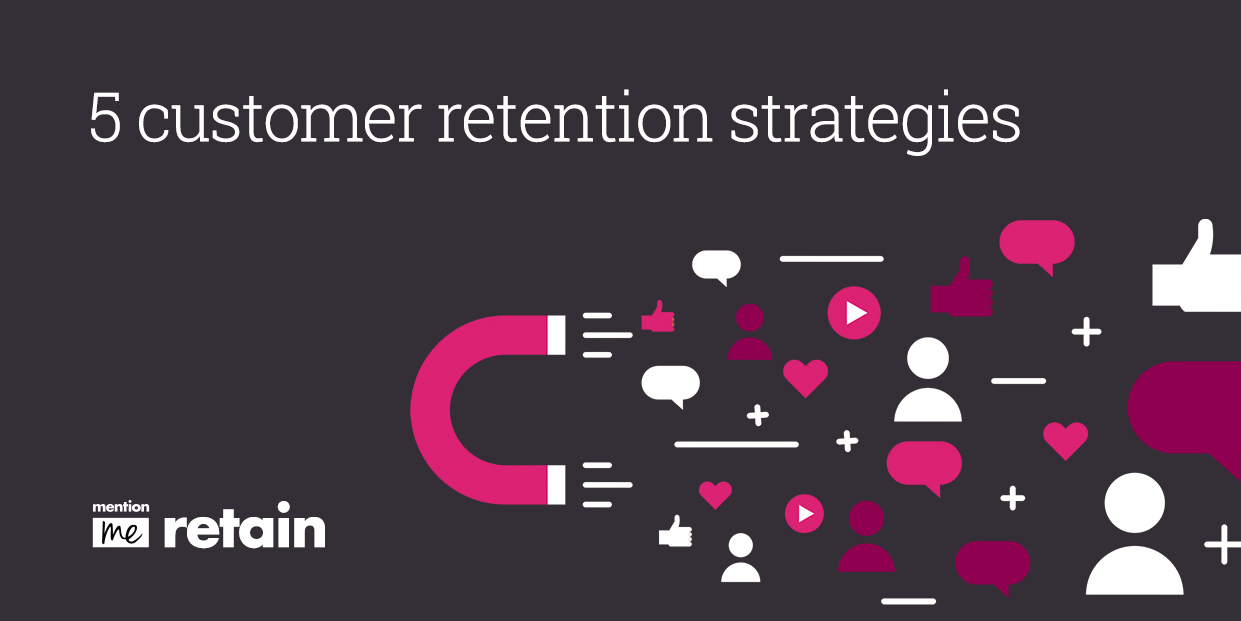14 Influencer Marketing Campaigns That Drive Millions in Revenue
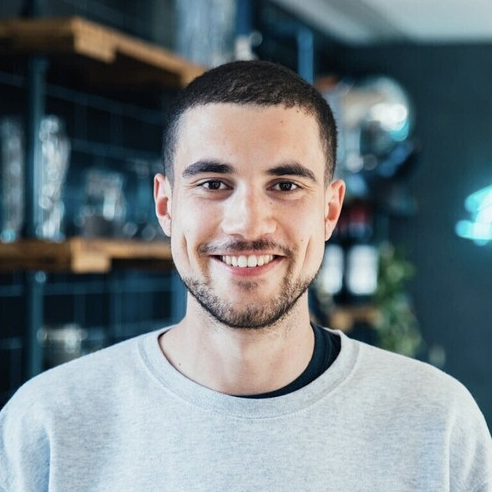
In recent years, influencer marketing has evolved from a brand-awareness lever to a serious performance channel. But while many brands are still measuring likes and views, the most successful campaigns have one thing in common: revenue.
When done right, influencer partnerships don’t just elevate visibility — they scale customer acquisition, drive conversions, and compound lifetime value.
Here’s how the top campaigns pulled it off.
Why Influencer Marketing Drives Revenue (When Done Right)
The logic behind high-performing influencer marketing is simple: people buy from those they trust.When a creator shares a product they genuinely love, their audience treats it as a recommendation — not an ad. That means less friction, faster decision-making, and higher conversion rates.
Here’s how the revenue funnel typically works in a high-impact influencer partnership:
Influencer Post → Link / Promo Code → Click to Product Page → Purchase → Retention → Referral
- Awareness: Creator introduces product in native content
- Consideration: Follower clicks bio link or uses code
- Purchase: Discount / endorsement helps drive conversion
- Retention: Great product experience encourages repeat purchase
- Advocacy: Customer becomes brand ambassador, furthering viral loop
But none of this works if your program is poorly executed. Let’s talk about what separates winners from wasted spend.
What Makes an Influencer Campaign Profitable
Not all influencer campaigns perform equally. The brands seeing genuine revenue uplift have a clear framework for success.
Here’s what they get right:
Aligned audience-product fit
Brands select influencers whose audiences already show buying signals for their product category.
Authentically integrated content
High-converting creators build trust through organic storytelling — not overly branded scripts.
Clear attribution
Smart brands use trackable links, custom promo codes, and influencer-specific dashboards to link content to conversion.
Optimised CTA timing
They know when their audience is most likely to act — and match campaigns to lifecycle touchpoints or seasonal micro-behaviours.
Iterative testing
Top campaigns don’t stop at one post. They A/B test formats, creators, messaging angles, and even platform placement.
With that in mind, here are 14 campaigns that prove influencer marketing isn’t about buzz — it’s about bottom-line impact.
7 Influencer Marketing Campaigns That Led to Revenue Explosion
Influencer marketing ROI has come a long way from aspirational selfies and generic taglines. Today, top brands are turning to micro-influencers, creator partnerships, and customer advocates to drive measurable, commerce-led growth.
To show what’s possible when it’s done right, we’ve rounded up 7 standout influencer marketing campaigns that didn’t just make noise—they drove serious revenue. From fashion to beauty to DTC powerhouses, these brands scaled through trust, creativity, and customer-first thinking.
1. Daniel Wellington — Fashion (Watches)

Campaign Overview
Daniel Wellington built an entire business on influencer marketing, transforming from a small Swedish watch startup to a global lifestyle brand in under five years.
Execution
The brand partnered with thousands of micro- and mid-tier influencers, gifting them free watches in exchange for social content. Each influencer received a unique discount code to share with their followers, linking directly to DW’s ecommerce store.
Results
Daniel Wellington generated over $200M+ in revenue within just three years of launching. The campaign drove direct conversions via promo codes, while the volume of content built persistent social proof across platforms.
Why It Worked
The brand layered reach with referral-style conversion tactics. Creator codes offered a strong purchase incentive, and the minimalist product aesthetic aligned well with Instagram’s aspirational visual culture.
Pro Tip
Use influencer discount codes not just for tracking — but to trigger urgency. “10% off this weekend only” adds a crucial conversion push.
2. Glossier — Beauty

Campaign Overview
Glossier’s meteoric rise was driven more by everyday users than traditional influencers. Their approach: turn customers into micro-influencers one recommendation at a time.
Execution
The brand encouraged happy customers to share selfies and reviews of products like Balm Dotcom and Milky Jelly Cleanser. Many were later packaged into high-performing influencer-style content — with Glossier elevating certain customers into official “reps” with referral codes and early access.
Results
Within three years, Glossier surpassed $100M in annual revenue, largely driven by community-powered growth. Their Instagram tagged section became a live feed of endorsements, driving discovery and EDLP (everyday low-pressure) sales conversions.
Why It Worked
It wasn’t influencer marketing in the traditional sense — it was customer storytelling. By spotlighting real users, Glossier built authentic brand trust at enormous scale.
Pro Tip
Build two tiers into your program: invite general customers to share feedback and visuals, and elevate high-performing advocates into ambassador or affiliate status.
3. Gymshark — Fitness Apparel

Campaign Overview
UK activewear brand Gymshark turned gym culture into a movement — and influencers were at the core.
Execution
Rather than rely on mega-celebrities, Gymshark partnered with rising fitness creators on YouTube and Instagram. These creators shared workout routines while wearing Gymshark gear, inserting promo codes into the description and linking through affiliate platforms.
Results
Gymshark reached $1.4B in valuation in under a decade and built one of the most iconic brand follower bases on Instagram. Customers were introduced through trusted creators, nudged via incentive, and sustained through product satisfaction and lifestyle alignment.
Why It Worked
The brand treated influencers as long-term brand partners, not just campaign activators. Their biggest creators — like Nikki Blackketter and Steve Cook — became synonymous with Gymshark's aesthetic and mission.
Pro Tip
Don’t just "feature" a creator — build with them. Gymshark cemented loyalty by co-creating product drops and including influencers in brand events, not just posts.
4. HelloFresh — Meal Kits

Campaign Overview
HelloFresh mastered the art of the performance-driven influencer campaign, largely through YouTube and podcast partnerships.
Execution
The brand worked with influencers across niches — from tech channels to family vloggers — giving them time-sensitive discount codes (e.g., “Get 16 free meals with code XYZ”). The content often showed the creator unboxing the meal kit and cooking the recipe, bridging lifestyle with product utility.
Results
HelloFresh consistently ranks as one of the top spenders in influencer and affiliate marketing in the US. Partnered creators often mention long-term affiliate revenue and repeat sponsorships, indicating strong conversion performance.
Why It Worked
HelloFresh optimised attribution at every point: each creator had a code, a dedicated landing page, and limited-time urgency. Plus, their full-funnel content format (watch → click → cook) mimicked real user purchase journeys.
Pro Tip
Influencers who use the product on camera — and build content around it versus just mentioning it — drive far higher conversion rates.
5. Fashion Nova
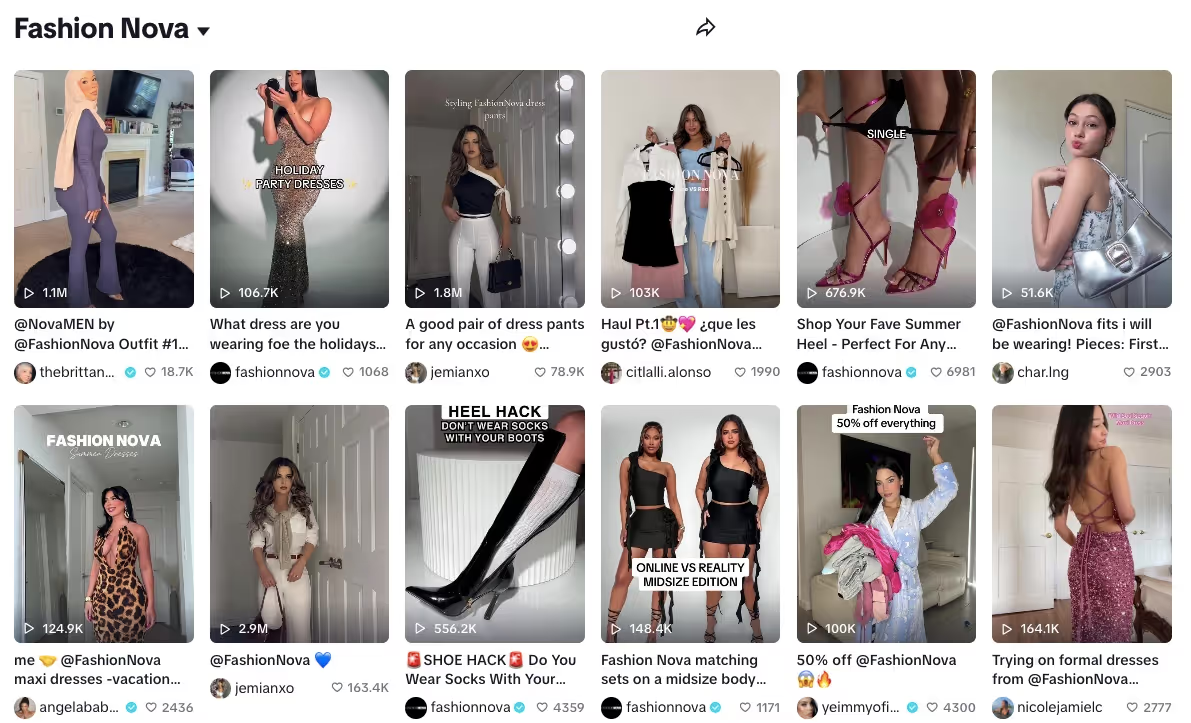
Campaign Overview
Fashion Nova made a name for itself as a kingpin of social-first fashion — with some of the fastest influencer activation cycles in the industry.
Execution
The brand scaled by recruiting thousands of micro- and macro-influencers — especially in hip-hop, reality TV, and urban fashion spaces. Influencers were paid to post mirror selfies and quick reels wearing Fashion Nova pieces, each timed with high-impact seasonal or time-limited sales. Tagging was part of the contract, alongside influencer-specific promo codes and affiliate links.
Results
Fashion Nova became one of the most Googled fashion brands in the U.S., topping Zara and Dior in search volume by 2018. The volume of influencer content flooded the Instagram feed, making the brand feel ever-present and trend-responsive. A large portion of sales were tied to code-driven campaigns from influencer partnerships.
Why It Worked
They didn’t overthink it. Fashion Nova understood its demographic — fast fashion customers — and flooded relevant creator communities with products, codes, and incentives. The brand wasn’t trying to win awards; it was built to win conversions on demand in high-volume social feeds.
Pro Tip
If your product is trend-led, speed to content matters more than polish. Build systems to activate, approve, and amplify influencer content on a 24–48-hour cycle.
6. Duolingo — EdTech
 Campaign Overview
Campaign Overview
Duolingo turned its quirky brand tone and viral mascot into one of the most recognisable creator-friendly personalities on TikTok.
Execution
While the brand’s own TikTok account drove millions of impressions through humorous content, Duolingo also partnered with creators for mock skits, reaction videos, and Duolingo challenge content. These creators weren’t language influencers — they were meme creators, comedians, students, and lifestyle vloggers. Each campaign had a clear CTA to install the app using the link in bio or caption.
Results
Duolingo achieved record engagement levels for an education brand. App installs saw measurable uplift following key creator partnerships (especially during campaign events like Back to School or New Year’s Resolution trends). Some of their influencer collabs overtook their branded channel content in reach.
Why It Worked
The execution understood platform culture and leaned into the absurdity of Duolingo’s own character. Influencers were given creative control to remix the brand their way — and the result was entertaining, native-feeling content that didn’t smell like advertising.
Pro Tip
One powerful creator video native to the platform is worth more than ten polished ads. Tone > polish.
7. Beis Travel

Campaign Overview
Founded by actress Shay Mitchell, Beis used both celebrity equity and influencer traction to become one of the fastest-growing travel accessories brands in its category.
Execution
Beis activated travel and lifestyle influencers to demonstrate how the bags fit into real travel moments — from airport “what’s in my bag” reels to packing guides and hotel room unboxings. Most content integrated promo codes, and Beis re-shared high-performing UGC on their brand and product pages.
Results
Beis saw triple-digit YoY revenue growth in its early years, and referral traffic through “influencer attribution” content now makes up a large portion of their DTC traffic mix. Products frequently sell out post-campaign.
Why It Worked
They didn’t force a hyper-polished aesthetic. Influencer content demoed the product in real-life scenarios and leaned into form + function storytelling that resonated with frequent flyers, parents, and digital nomads alike.
Pro Tip
Use influencer UGC to fuel your onsite ecommerce experience — UGC product pages have repeated shown higher CVR and lower bounce rates.
8. Revolve — Fashion/Retail

Campaign Overview
Revolve pioneered the influencer trip model — turning unpaid content into performance marketing that drives both IRL engagement and ecommerce spikes.
Execution
The brand took select macro-influencers on curated “Revolve Around the World” trips, where creators were styled in Revolve pieces for coordinated content drops. Hashtags trended for days during each trip, driving FOMO-led discovery and “shop the look” conversions through links in bio or Revolve's shopping app.
Results
Revolve saw direct spikes in sales tied to trip weekends and coordinated influencer posting timelines. Returns from Revolve’s own influencer affiliate programme became a core component of their DTC analytics stack, with multiple six-figure revenue days connected to these experiences.
Why It Worked
They didn’t just do brand awareness — they turned moments into measurable demand. Influencers were styled, paid, and tracked individually.
Pro Tip
If you’re investing in in-person content or experience trips, set up ROI infrastructure to prove each creator’s sales impact — not just their reach.
9. CASETiFY — Tech Accessories

Campaign Overview
CASETiFY turned iPhone cases into fashion statements — and scaled through influencer collabs that felt limited, cool, and highly visual.
Execution
The brand launched limited-edition partnerships with artists, celebrities, and creators. Influencers were contracted to unbox, demo, and shoot stylised content showing off the newest case lines, with urgency-driven hooks like “only 500 made.” Custom links and “early access” rewards were part of the setup.
Results
Multiple collections sold out in hours. Traffic from influencer-linked content converted at over 2× CASETiFY’s average. Select partnerships (such as with BTS or Olivia Rodrigo) turned into 7-figure revenue events.
Why It Worked
CASETiFY used influencer campaigns like fashion drops — creating hype and urgency around each new line. The cases became a form of social expression, backed by creator style validation.
Pro Tip
Turn your influencer content into episodic product storytelling. Treat drops like events, and creators like launch partners — not just promoters.
10. Liquid I.V. — Health & Wellness

Campaign Overview
Liquid I.V. used informative influencer content to position itself as a hydration essential — not just a wellness trend.
Execution
The brand partnered with wellness creators, athletes, nurses, and lifestyle influencers to educate audiences on hydration benefits, especially around altitude, fitness, or travel. Many creators filmed “day in the life” videos featuring drink prep with their Liquid I.V., pairing it with discount codes and referral links.
Results
The combination of content volume and trust-based education helped Liquid I.V. reach 9-figure revenue milestones. Influencer-linked codes became reliable tools for new customer acquisition across YouTube, Instagram, and TikTok.
Why It Worked
The product required small education — so the brand let content do the work. The visual nature of the powder and shaker bottle helped reinforce usability.
Pro Tip
Pair your product’s use case with trusted professionals — e.g., Liquid I.V. used pilots, nurses, and marathoners to create macro trust.
11. Manscaped — Men's Grooming

Campaign Overview
Manscaped leaned into edgy humour and relatability to dominate male grooming across influencer audiences.
Execution
The brand distributed products to comedy podcasters, YouTubers, and meme accounts, allowing them to create ads that broke the mold — satirical, irreverent, and self-deprecating. Discount codes like “MAN20” became synonymous with the brand.
Results
Sales soared, especially after working with creators in the sports and entertainment space (e.g., Barstool Sports). Their name recognition rivalled legacy grooming brands — without traditional media.
Why It Worked
Manscaped trusted creators to deliver the tone that resonated with their audience. Instead of cleaning up the humor, they doubled down on it — and got rewarded with viral content and high conversion rates.
Pro Tip
If your product lends itself to awkward conversations or taboo topics — find creators who can tackle them on behalf of the audience.
12. Bang Energy — Beverages
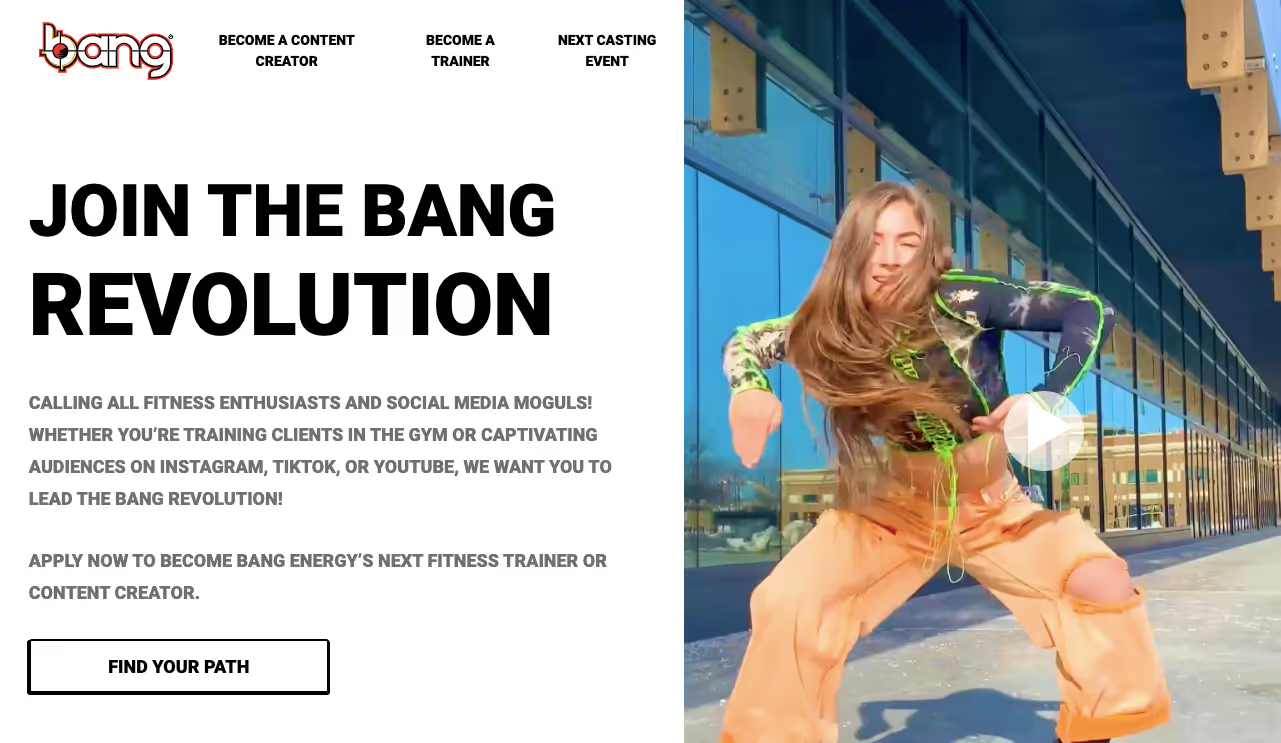
Campaign Overview
Bang Energy took over TikTok for nearly three years by giving free product, loose direction, and full creative control to thousands of micro and macro influencers.
Execution
The brand encouraged dance trends, gym routines, and outrageous skits featuring the drink. There was no uniform brand aesthetic. Influencers were paid based on views and performance, and new creators were onboarded monthly with their own discount codes.
Results
Bang Energy built massive brand awareness on TikTok — generating hundreds of millions of views and solidifying its branding with younger, health-conscious audiences. Sales followed, particularly via GNC and DTC.
Why It Worked
They embraced chaos. The unpolished, prolific volume approach maximized reach and cultural relevance. What looked silly sometimes sold serious volume.
Pro Tip
If your category is oversaturated, sometimes ubiquity wins. Target aggressive volume early — refine later.
13. Magic Spoon — Cereal
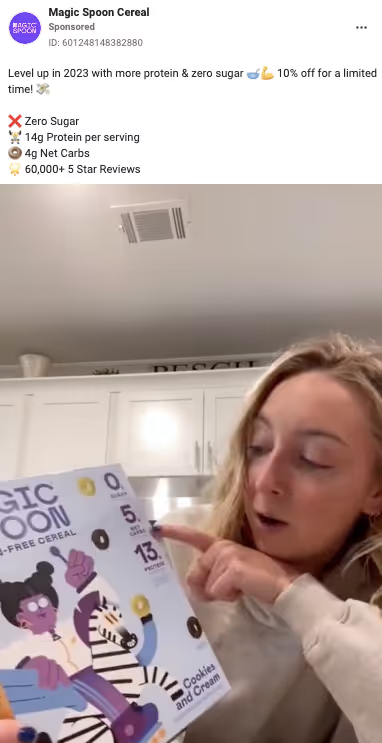
Campaign Overview
Magic Spoon rebranded sugary cereal as a high-protein keto treat for adults, using influencers to make nostalgia a growth lever.
Execution
Podcasters and YouTubers integrated the cereal into daily life — breakfast routines, snack boxes, etc. Each creator received affiliate codes, often paired with humorous storytelling around “guilt-free breakfast.”
Results
DTC sales exploded. Magic Spoon transitioned from 6-figure weeks to 7-figure months. B2B distribution began growing off the back of influencer-driven DTC brand equity.
Why It Worked
The messaging (protein-packed, kid-style cereal for grown-ups) fit seamlessly into influencer storytelling formats.
Pro Tip
Build a brand story, then invite influencers to adapt it into their world. The joke is part of the funnel.
14. Airbnb
 Lady Gaga's influencer campaign for Airbnb drove impressive results
Lady Gaga's influencer campaign for Airbnb drove impressive results
Campaign Overview
Airbnb, always at the forefront of digital-first growth, expanded its reach by utilising creators as storytellers and local explorers.
Execution
The brand partnered with photographers, travel vloggers, and creators exploring unique stays — treehouses, off-grid cabins, city lofts. Content focused on the “experience” side of hosting and staying, not just transactions. Each campaign included tracking links and personalised codes.
Results
Influencer campaigns helped Airbnb deepen its community-driven ethos, increase bookings in remote destinations, and build long-form content assets for paid retargeting. Several creators achieved 6- and 7-figure referral revenue through affiliate partnerships.
Why It Worked
Airbnb understood that storytelling, not selling, was the ROI multiplier. They let creators guide the narrative naturally.
Pro Tip
In the travel vertical, aesthetic matters. Invest in creators with strong visual identity and video storytelling expertise.
How to Design a Revenue-First Influencer Campaign
Great influencer content doesn’t always lead to great business results. If the goal is to drive real revenue — not just reach — campaigns must be engineered with performance from the outset.
A revenue-first influencer campaign prioritises metrics that connect activity to transactions: purchases, average order value, customer acquisition cost, and lifetime value. It’s built with a structured funnel in mind — from creator selection to conversion tracking — and designed to optimise at every stage.
Here’s how to build one that works.
Define a revenue-related KPI (CPA, ROAS, conversions)
Before you choose a creator, define success. What exactly does your business want from this influencer campaign? Are you aiming to drive first-time customer acquisition? Reduce cost per acquisition compared to paid ads? Increase average order value? Push high-margin SKUs?Choose a clear, customer-linked KPI. The most common include:
- CPA (cost per acquisition from influencer traffic)
- ROAS (return on ad spend through influencer-paid partnerships)
- Conversion rate (site visits to purchases)
- CAC payback time
- LTV of influenced customers
Once your core KPI is set, ensure it’s trackable through a UTM structure, influencer affiliate dashboard, or code redemption logic.
Choose influencer types by funnel stage (macro for awareness, micro for conversions)
All influencers are not the same — and shouldn’t be used the same way. Think about your campaign goal. If you want reach and cultural association, macro- or celebrity-level influencers (100K–1M+ followers) may be your best fit. For engagement and conversion, it’s often the micro tier (10K–50K followers) that outperforms.Top-performing brands match influencer tier with the funnel stage:
- Top of Funnel (TOFU): Macro influencers boost awareness and create social proof
- Middle of Funnel (MOFU): Mid-tier influencers drive consideration and content commitments
- Bottom of Funnel (BOFU): Micro-influencers convert, educate, and build buying trust
Some campaigns may use two or three tiers together — but success depends on knowing who's responsible for which part of the buyer journey.
Set up affiliate tracking or unique discount codes
Revenue-focused campaigns must connect creator activity to tracked sales. The most effective way to do this is through affiliate links, influencer dashboards, or personalised discount codes. This allows you to monitor performance in real time — and reward accordingly.Your setup should include:
- UTM parameters embedded in tracked links
- Creator-specific promo codes (e.g. “JENNY10”)
- Attribution windows aligned to buying cycle (e.g. 14 to 30 days)
- Integration with ecommerce — Shopify, WooCommerce, etc.
- Reporting shared with creators (influencer dashboards or performance emails)
Personalised codes don’t just improve attribution — they increase conversion rates. Promo codes signal exclusivity, urgency, and peer endorsement all at once.
Provide creative guidance, but let creators be authentic
Performance doesn’t require controlling every frame. Today’s audiences are trained to filter out polished ad content. What they respond to is authenticity. That’s why brands who co-create — rather than script — tend to win more clicks and sales.Set creative guidelines around key requirements:
- Where and when to mention the brand
- What the CTA should include
- Required visual elements (e.g. product in frame, packaging unboxing)
- Platform format (e.g. Reel over Story)
But don’t dictate the voice. The more you let the creator embed your product into their unique style, the more trustworthy your brand becomes by association.
Monitor in real time and double down on high performers
Once your campaign is live, the work isn’t over — it’s just beginning. Monitoring performance in real time lets you identify which creators are driving action, and where there's room to pivot.Key actions to take mid-campaign:
- Shift paid spend behind top-performing creators
- Repurpose best content for UGC-style ads
- Pause or rescope underperformers
- Use top creators’ learnings to rebrief mid-tier performers
Pay special attention to conversion rate, bounce rate, and secondary actions (e.g. email signups or add to cart) if purchases aren’t immediate.
Repurpose best content across channels (ads, product pages, email)
Don’t let great content die with the post. High-performing influencer content is one of the best sources of convertible creative for paid ads, email marketing, landing pages, product pages, and even post-purchase flows.Approved content repurposing looks like:
- Placing influencer quotes or videos on PDPs
- Using UGC in retargeting ad campaigns
- Embedding creator reviews in post-purchase emails
- Clipping snackable explainer content for TikTok ads or Meta carousel units
This turns one campaign into a full-funnel content machine — improving both marketing efficiency and your media ROI.
Common Mistakes to Avoid
Even data-backed influencer programs can fall apart if the foundations aren’t right. These are some of the most common mistakes that derail campaigns designed to drive revenue:- Using the wrong creators — Audience alignment matters more than follower count. A macro creator outside your niche will rarely convert efficiently.
- Forgetting attribution setup — If you can’t track the performance of a creator, you can’t optimise spend. UTM, code, and pixel-based setups are essential.
- Over-scripting creative — Creators who sound like they're reading an ad lose trust, fast. Let them communicate value naturally in their own tone.
- Not aligning incentives — Influencer programs should reward based on performance, not presence. Tier your rewards or structure a hybrid fee + affiliate model.
- Focusing only on discounts — Not every product benefits from a discount-first pitch. If the product is premium, focus on value, quality, or social status.
- Failing to retarget — Traffic without retargeting is a missed opportunity. Build remarketing ads using engaged visit data from influencer traffic.
Conclusion
Influencer marketing doesn’t just drive likes. When it’s structured with KPIs, creative freedom, and conversion tracking — it becomes a measurable revenue channel.
The brands leading in performance-influencer marketing reverse-engineer their programs to track attribution, incentivise creators properly, and double down on what works. They understand that influence, when paired with data, is a force multiplier for profitable acquisition.
If you’re ready to scale organic growth with influencers who move the needle — not just the follower count — start with intent, build around value, and let performance guide you.
Ready to build an influencer program that proves ROI and delivers profitable growth? Talk to our micro-influencer experts today and build the program you always meant to launch.

Dan Barraclough
Read more >
Never miss another update
Subscribe to our blog and get monthly emails packed full of the latest marketing trends and tips





